Low-Computational Model to Predict Individual Temperatures of Cells within Battery Modules
Abstract
1. Introduction
2. Modeling Procedure
2.1. Modeling Overview
- In order to evaluate the heat source, the current profile, applied on the battery during the operating cycles, is employed as the input value of the electrical model.
- The estimated heat source is then used as an input, with other significant parameters, of the thermal model, to predict the temperature of the battery.
- In order to include the thermal impact on the electrical resistance, and thus on the heat generated, the temperature predicted is re-inputted into the electrical model.
2.2. Cell Specifications and Design
2.3. Electrical Model: Newman, Tiedman, Gu, and Kim Formulation (NTGK)
2.4. Thermal Model: Finite Element 3D Model (Reference Model)
2.5. Thermal Model: Lumped 3D Thermal Resistance Model
3. Results and Discussions
3.1. Discharge Cycles
3.1.1. Single-Cell Simulation
3.1.2. Module Simulation
3.2. Periodic Cycles (Charge/Discharge)
3.2.1. Single-Cell Simulation
3.2.2. Module Simulation
4. Conclusions
Author Contributions
Funding
Data Availability Statement
Conflicts of Interest
Nomenclature
| A | surface area exposed to air [m2] | S | normal area [m2] |
| a, b | constants used in the fits | t | time [s] |
| Cnom | nominal Capacity [Ah] | T | temperature [K] |
| Cp | specific heat capacity [J/kg K] | Ta | ambient temperature [K] |
| DOD | depth of discharge | Ti,c | cell internal temperature [K] |
| h | heat Transfer coefficient [W m2/K] | Ti,g | gap internal temperature [K] |
| I | current [A] | Ti,p | positive tab internal temperature [K] |
| L | length [m] | Ti,n | negative tab internal temperature [K] |
| qconv | convection heat flux [W] | Tref | reference temperature [K] |
| Qirr | irreversible heat generated [W] | Ts | surface temperature [K] |
| Relc | electrical resistance [Ω] | Ucell | cell voltage [V] |
| Rc | heat transfer resistance inside the cell [K/W] | UOCV | open circuit voltage [V] |
| Rhc | heat transfer resistance outside the cell [K/W] | V | volume [m3] |
| Rg | heat transfer resistance inside the insulator [K/W] | x, y, z | coordinates components [m] |
| Rhg | heat transfer resistance outside the insulator [K/W] | ω1, ω2 | constants used in the fits |
| Rhn | heat transfer resistance outside the negative tab [K/W] | ρ | density [Kg/m3] |
| Rhp | heat transfer resistance outside the positive tab [K/W] | λ | thermal conductivity [W.m/K] |
| Rn | heat transfer resistance inside the negative tab [K/W] | δ | thickness [m] |
| Rp | heat transfer resistance inside the positive tab [K/W] |
Appendix A. Tables
| Characteristics | Value |
|---|---|
| Cell format | Pouch |
| Cell chemistry | NMC/Graphite |
| Cell dimensions | 196 × 127 × 7 mm |
| Tabs dimensions | 30 × 23 × 6 mm |
| Nominal capacity | 14.6 Ah |
| Nominal voltage | 3.65 V |
| Charge cut-off voltage | 4.2 V |
| Discharge cut-off voltage | 2.9 V |
| Parameter | Coefficient | |||||
|---|---|---|---|---|---|---|
| Uocv | a0 4.12 | a1 −0.804 | a2 1.075 | a3 −1.177 | a4 0 | a5 0 |
| Relc | b0 86 × 10−5 | b1 −11 × 10−5 | b2 19 × 10−6 | b3 −73 × 10−7 | b4 63 × 10−7 | b5 15 × 10−6 |
| ω1 | 94 × 10−4 | |||||
| ω2 | 1800 | |||||
| Field | δ | ρ | Cp | λ | σ |
|---|---|---|---|---|---|
| Al | 0.357 × 10−3 | 2702 | 903 | 238 | 378 × 105 |
| NMC | 2.38 × 10−3 | 2895 | 1270 | 1.58 | 13.9 |
| Separator | 0.9 × 10−3 | 1017 | 1978 | 0.34 | -- |
| Cu | 0.215 × 10−3 | 8933 | 385 | 398 | 596 × 105 |
| Graphite | 2.84 × 10−3 | 1555 | 1437 | 1.04 | 100 |
| Pouch | 0.324 × 10−3 | 1150 | 1900 | 16 | -- |
| Parameters | Value |
|---|---|
| δ | 0.002 mm |
| ρ | 195 kg/m3 |
| Cp | 1800 J/kg K |
| λ | 0.002 W/m K |
| Resistance | Equation | Symbolization and Definition | Values of the Parameters in the Equations | ||
|---|---|---|---|---|---|
| Conductive resistance | Rc = L/2λS | Rcx: Resistance in the cell x-axis | L = 0.127 m | λ = 25.4 W/m K | S = 1.37 × 10−3 m2 |
| Rcy: Resistance in the cell y-axis | L = 0.196 m | λ = 25.4 W/m K | S = 8.89 × 10−4 m2 | ||
| Rcz: Resistance in the cell z-axis | L = 0.007 m | λ = 0.79 W/m K | S = 2.49 × 10−2 m2 | ||
| Rpx: Resistance in the positive tab x-axis | L = 0.023 m | λ = 238 W/m K | S = 1.84 × 10−4 m2 | ||
| Rpy: Resistance in the positive tab y-axis | L = 0.03 m | λ = 238 W/m K | S = 1.38 × 10−4 m2 | ||
| Rpz: Resistance in the positive tab z-axis | L = 0.006 m | λ = 238 W/m K | S = 6.9 × 10−4 m2 | ||
| Rnx: Resistance in the negative tab x-axis | L = 0.023 m | λ = 398 W/m K | S = 1.84 × 10−4 m2 | ||
| Rny: Resistance in the negative tab y-axis | L = 0.03 m | λ = 398 W/m K | S = 1.38 × 10−4 m2 | ||
| Rnz: Resistance in the negative tab z-axis | L = 0.006 m | λ = 398 W/m K | S = 6.9 × 10−4 m2 | ||
| Rgx: Resistance in the aerogel x-axis | L = 0.127 m | λ = 2 × 10−3 W/m K | S = 392 × 10−6 m2 | ||
| Rgy: Resistance in the aerogel y-axis | L = 0.196 m | λ = 2 × 10−3 W/m K | S = 254 × 10−6 m2 | ||
| Rgz: Resistance in the aerogel z-axis | L = 0.002 m | λ = 2 × 10−3 W/m K | S = 249 × 10−4 m2 | ||
| Convective resistance | Rh = 1/hS | Rhcx: Resistance cell/ambient x-axis | h = 5 W/m2 K | S = 1.37 × 10−3 m2 | |
| Rhcy: Resistance cell/ambient y-axis | h = 5 W/m2 K | S = 8.89 × 10−4 m2 | |||
| Rhcz: Resistance cell/ambient z-axis | h = 5 W/m2 K | S = 2.49 × 10−2 m2 | |||
| Rhpx, Rhnx: Resistances tabs/ambient x-axis | h = 5 W/m2 K | S = 1.84 × 10−4 m2 | |||
| Rhpy, Rhny: Resistances tabs/ambient y-axis | h = 5 W/m2 K | S = 1.38 × 10−4 m2 | |||
| Rhpz, Rhnz: Resistance tabs/ambient z-axis | h = 5 W/m2 K | S = 6.9 × 10−4 m2 | |||
| Rhgx: Resistance aerogel/ambient x-axis | h = 5 W/m2 K | S = 3.92 × 10−4 m2 | |||
| Rhgy: Resistance aerogel/ambient y-axis | h = 5 W/m2 K | S = 2.54 × 10−4 m2 | |||
References
- Pan, D.; Guo, H.; Tang, S.; Li, X.; Wang, Z.; Peng, W.; Wang, J.; Yan, G. Evaluating the accuracy of electro-thermal coupling model in lithium-ion battery via altering internal resistance acquisition methods. J. Power Sources 2020, 463, 228174. [Google Scholar] [CrossRef]
- Raijmakers, L.; Danilov, D.; Eichel, R.-A.; Notten, P. A review on various temperature-indication methods for Li-ion batteries. Appl. Energy 2019, 240, 918–945. [Google Scholar] [CrossRef]
- Hassini, M.; Redondo-Iglesias, E.; Venet, P. Second-Life Batteries Modeling for Performance Tracking in a Mobile Charging Station. World Electr. Veh. J. 2023, 14, 94. [Google Scholar] [CrossRef]
- Liu, J.; Yadav, S.; Salman, M.; Chavan, S.; Kim, S.C. Review of thermal coupled battery models and parameter identification for lithium-ion battery heat generation in EV battery thermal management system. Int. J. Heat Mass Transf. 2024, 218, 124748. [Google Scholar] [CrossRef]
- Ma, S.; Jiang, M.; Tao, P.; Song, C.; Wu, J.; Wang, J.; Deng, T.; Shang, W. Temperature effect and thermal impact in lithium-ion batteries: A review. Prog. Nat. Sci. 2018, 28, 653–666. [Google Scholar] [CrossRef]
- Wu, Y.; Keil, P.; Schuster, S.F.; Jossen, A. Impact of Temperature and Discharge Rate on the Aging of a LiCoO2/LiNi0.8Co0.15Al0.05O2Lithium-Ion Pouch Cell. J. Electrochem. Soc. 2017, 164, A1438–A1445. [Google Scholar] [CrossRef]
- Olabi, A.; Maghrabie, H.M.; Adhari, O.H.K.; Sayed, E.T.; Yousef, B.A.; Salameh, T.; Kamil, M.; Abdelkareem, M.A. Battery thermal management systems: Recent progress and challenges. Int. J. Thermofluids 2022, 15, 100171. [Google Scholar] [CrossRef]
- Yang, T.; Yang, N.; Zhang, X.; Li, G. Investigation of the thermal performance of axial-flow air cooling for the lithium-ion battery pack. Int. J. Therm. Sci. 2016, 108, 132–144. [Google Scholar] [CrossRef]
- Bryden, T.S.; Dimitrov, B.; Hilton, G.; de León, C.P.; Bugryniec, P.; Brown, S.; Cumming, D.; Cruden, A. Methodology to determine the heat capacity of lithium-ion cells. J. Power Sources 2018, 395, 369–378. [Google Scholar] [CrossRef]
- Morali, U. A numerical and statistical implementation of a thermal model for a lithium-ion battery. Energy 2021, 240, 122486. [Google Scholar] [CrossRef]
- Kwon, K.H.; Shin, C.B.; Kang, T.H.; Kim, C.-S. A two-dimensional modeling of a lithium-polymer battery. J. Power Sources 2006, 163, 151–157. [Google Scholar] [CrossRef]
- Kim, G.-H.; Smith, K.; Lee, K.-J.; Santhanagopalan, S.; Pesaran, A. Multi-Domain Modeling of Lithium-Ion Batteries Encompassing Multi-Physics in Varied Length Scales. J. Electrochem. Soc. 2011, 158, A955–A969. [Google Scholar] [CrossRef]
- Liu, J.; Chavan, S.; Kim, S.-C. Investigation of the Electrochemical and Thermal Characteristics of NCM811-21700 Cylindrical Lithium-Ion Battery: A Numerical Study and Model Validation. Energies 2023, 16, 6407. [Google Scholar] [CrossRef]
- Jokar, A.; Rajabloo, B.; Désilets, M.; Lacroix, M. Review of simplified Pseudo-two-Dimensional models of lithium-ion batteries. J. Power Sources 2016, 327, 44–55. [Google Scholar] [CrossRef]
- Hamisi, C.M.; Chombo, P.V.; Laoonual, Y.; Wongwises, S. An Electrothermal Model to Predict Thermal Characteristics of Lithium-Ion Battery under Overcharge Condition. Energies 2022, 15, 2284. [Google Scholar] [CrossRef]
- Liu, Y.; Liao, Y.G.; Lai, M.-C. Transient Temperature Distributions on Lithium-Ion Polymer SLI Battery. Vehicles 2019, 1, 127–137. [Google Scholar] [CrossRef]
- Zhang, H.; Li, C.; Zhang, R.; Lin, Y.; Fang, H. Thermal analysis of a 6s4p Lithium-ion battery pack cooled by cold plates based on a multi-domain modeling framework. Appl. Therm. Eng. 2020, 173, 115216. [Google Scholar] [CrossRef]
- Forgez, C.; Do, D.V.; Friedrich, G.; Morcrette, M.; Delacourt, C. Thermal modeling of a cylindrical LiFePO4/graphite lithium-ion battery. J. Power Sources 2010, 195, 2961–2968. [Google Scholar] [CrossRef]
- Damay, N.; Forgez, C.; Bichat, M.-P.; Friedrich, G. Thermal modeling of large prismatic LiFePO4/graphite battery. Coupled thermal and heat generation models for characterization and simulation. J. Power Sources 2017, 283, 37–45. [Google Scholar] [CrossRef]
- Akbarzadeh, M.; Kalogiannis, T.; Jaguemont, J.; He, J.; Jin, L.; Berecibar, M.; Van Mierlo, J. Thermal modeling of a high-energy prismatic lithium-ion battery cell and module based on a new thermal characterization methodology. J. Energy Storage 2020, 32, 101707. [Google Scholar] [CrossRef]
- Jiang, Z.; Qu, Z.; Zhang, J.; Rao, Z. Rapid prediction method for thermal runaway propagation in battery pack based on lumped thermal resistance network and electric circuit analogy. Appl. Energy 2020, 268, 115007. [Google Scholar] [CrossRef]
- Abbas, A.; Rizoug, N.; Trigui, R.; Redondo-Iglesias, E.; Pelissier, S. Simulation of the Thermal Behavior of NMC Module under Different Electrical Scenarios. In Proceedings of the 2023 IEEE Vehicle Power and Propulsion Conference (VPPC), Milan, Italy, 23–27 October 2023; pp. 1–6. [Google Scholar]
- Paccha-Herrera, E.; Calderón-Muñoz, W.R.; Orchard, M.; Jaramillo, F.; Medjaher, K. Thermal Modeling Approaches for a LiCoO2 Lithium-ion Battery—A Comparative Study with Experimental Validation. Batteries 2020, 6, 40. [Google Scholar] [CrossRef]
- Gu, H. Mathematical Analysis of a Zn/NiOOH Cell. J. Electrochem. Soc. 1983, 130, 1459–1464. [Google Scholar] [CrossRef]
- Kim, U.S.; Yi, J.; Shin, C.B.; Han, T.; Park, S. Modeling the Dependence of the Discharge Behavior of a Lithium-Ion Battery on the Environmental Temperature. J. Electrochem. Soc. 2011, 158, A611. [Google Scholar] [CrossRef]
- Immonen, E.; Hurri, J. Incremental thermo-electric CFD modeling of a high-energy Lithium-Titanate Oxide battery cell in different temperatures: A comparative study. Appl. Therm. Eng. 2021, 197, 117260. [Google Scholar] [CrossRef]
- Chacko, S.; Chung, Y.M. Thermal modelling of Li-ion polymer battery for electric vehicle drive cycles. J. Power Sources 2012, 213, 296–303. [Google Scholar] [CrossRef]
- Liu, X.; Ai, W.; Marlow, M.N.; Patel, Y.; Wu, B. The effect of cell-to-cell variations and thermal gradients on the performance and degradation of lithium-ion battery packs. Appl. Energy 2019, 248, 489–499. [Google Scholar] [CrossRef]
- Ziat, K.; Louahlia, H.; Petrone, R.; Gualous, H.; Schaetzel, P. Experimental investigation on the impact of the battery charging/discharging current ratio on the operating temperature and heat generation. Int. J. Energy Res. 2021, 45, 16754–16768. [Google Scholar] [CrossRef]
- Viswanathan, V.V.; Choi, D.; Wang, D.; Xu, W.; Towne, S.; Williford, R.E.; Zhang, J.-G.; Liu, J.; Yang, Z. Effect of entropy change of lithium intercalation in cathodes and anodes on Li-ion battery thermal management. J. Power Sources 2010, 195, 3720–3729. [Google Scholar] [CrossRef]
- Smith, K.; Wang, C.-Y. Power and thermal characterization of a lithium-ion battery pack for hybrid-electric vehicles. J. Power Sources 2006, 160, 662–673. [Google Scholar] [CrossRef]
- Taheri, P.; Yazdanpour, M.; Bahrami, M. Transient three-dimensional thermal model for batteries with thin electrodes. J. Power Sources 2013, 243, 280–289. [Google Scholar] [CrossRef]
- Chen, S.; Wan, C.; Wang, Y. Thermal analysis of lithium-ion batteries. J. Power Sources 2005, 140, 111–124. [Google Scholar] [CrossRef]
- Frackowiak, E.; Béguin, F. Carbon materials for the electrochemical storage of energy in capacitors. Carbon 2001, 39, 937–950. [Google Scholar] [CrossRef]
- Yang, X.; Duan, Y.; Feng, X.; Chen, T.; Xu, C.; Rui, X.; Ouyang, M.; Lu, L.; Han, X.; Ren, D.; et al. An Experimental Study on Preventing Thermal Runaway Propagation in Lithium-Ion Battery Module Using Aerogel and Liquid Cooling Plate Together. Fire Technol. 2020, 56, 2579–2602. [Google Scholar] [CrossRef]
- Bejan, A. Convection Heat Transfer; John Wiley & Sons: New York, NY, USA, 2013. [Google Scholar]
- Rizk, R.; Louahlia, H.; Gualous, H.; Schaetzel, P. Experimental analysis and transient thermal modelling of a high capacity prismatic lithium-ion battery. Int. Commun. Heat Mass Transf. 2018, 94, 115–125. [Google Scholar] [CrossRef]
- ANSYS Inc. ANSYS Fluent Theory Guide (Release 2021 R1); ANSYS Inc.: Canonsburg, PA, USA, 2021. [Google Scholar]
- The MathWorks, Inc. MATLAB Version:9.9.0 (R2020b). 2020. Available online: https://www.mathworks.com (accessed on 1 April 2022).





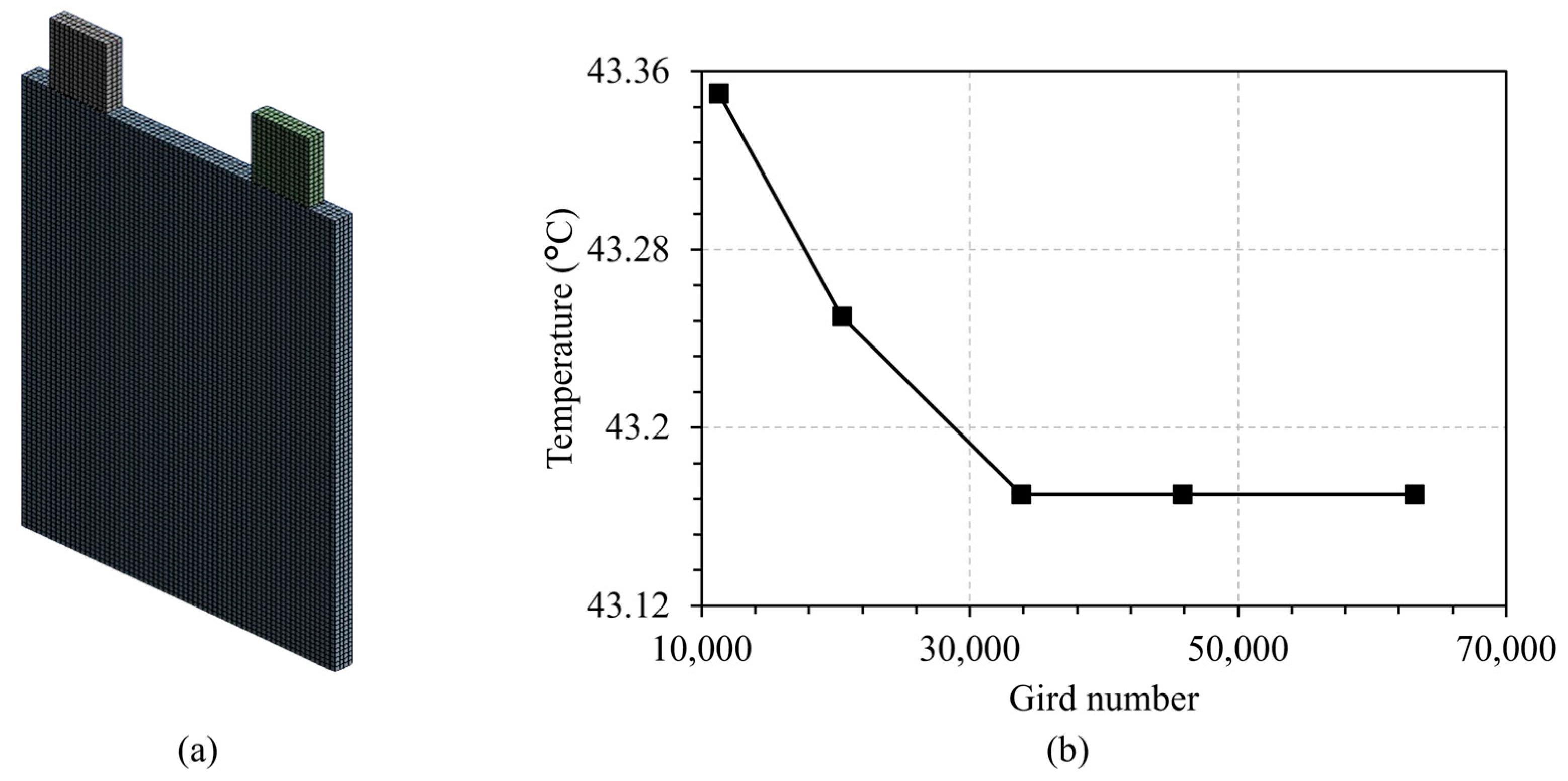


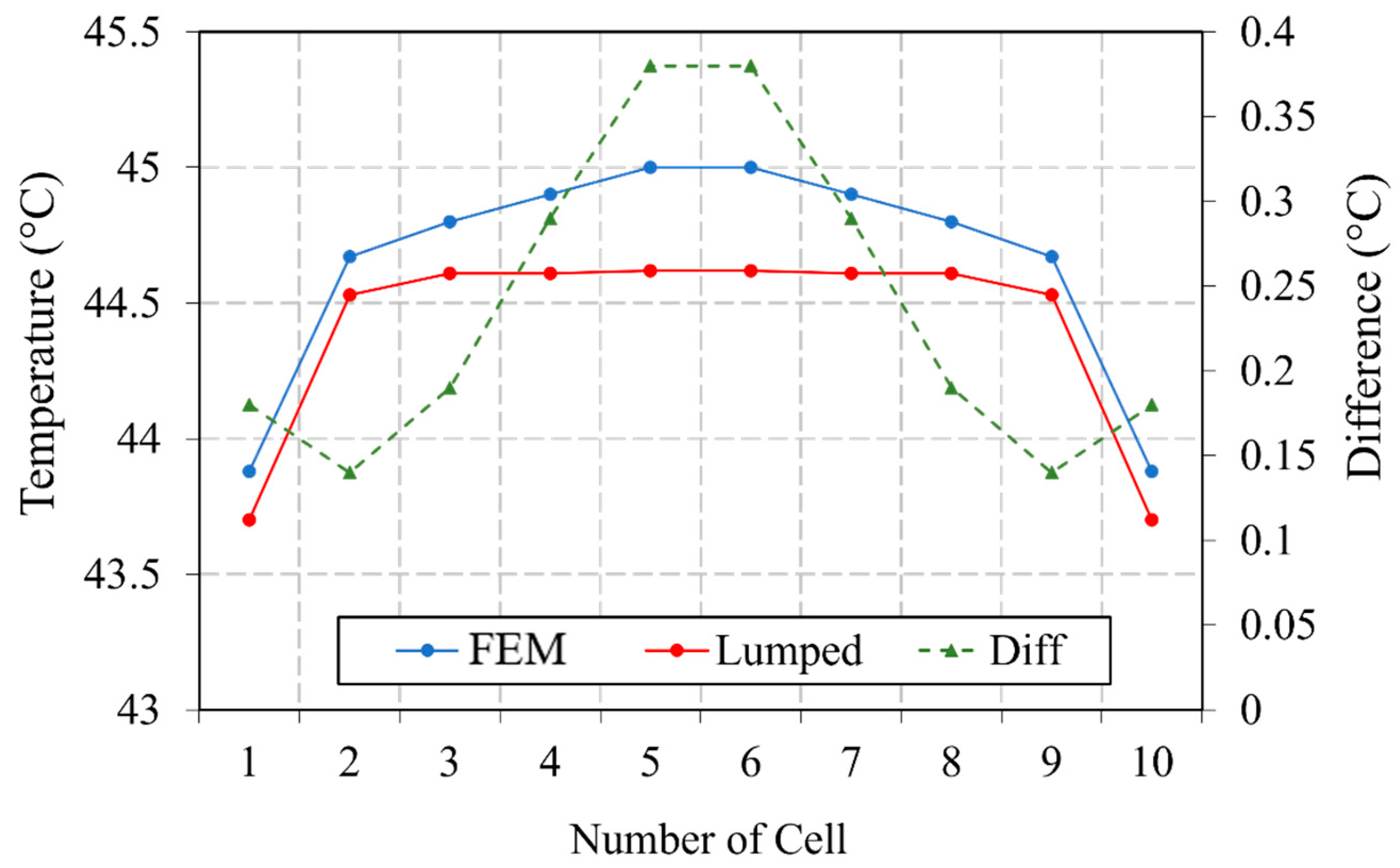
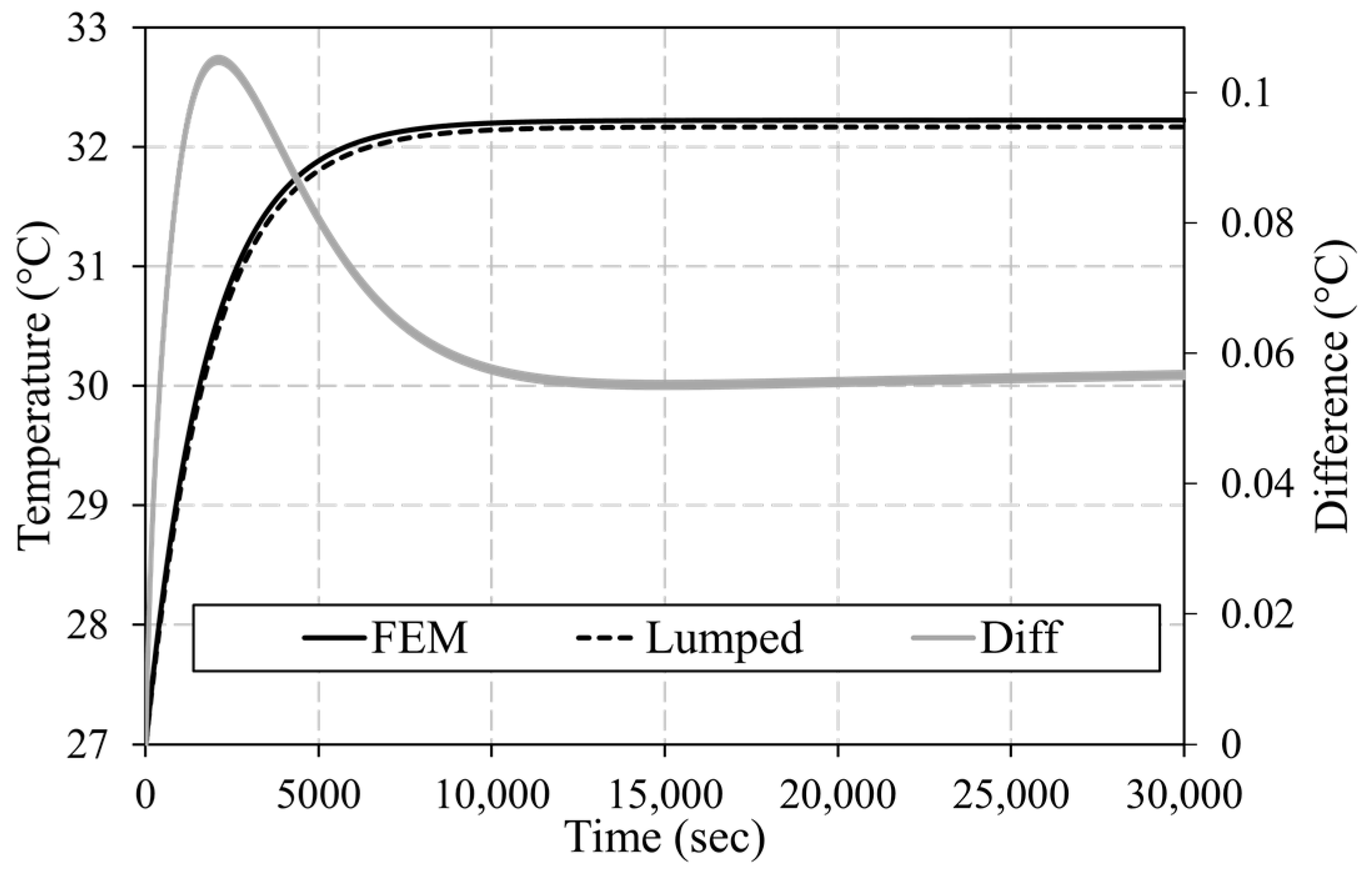
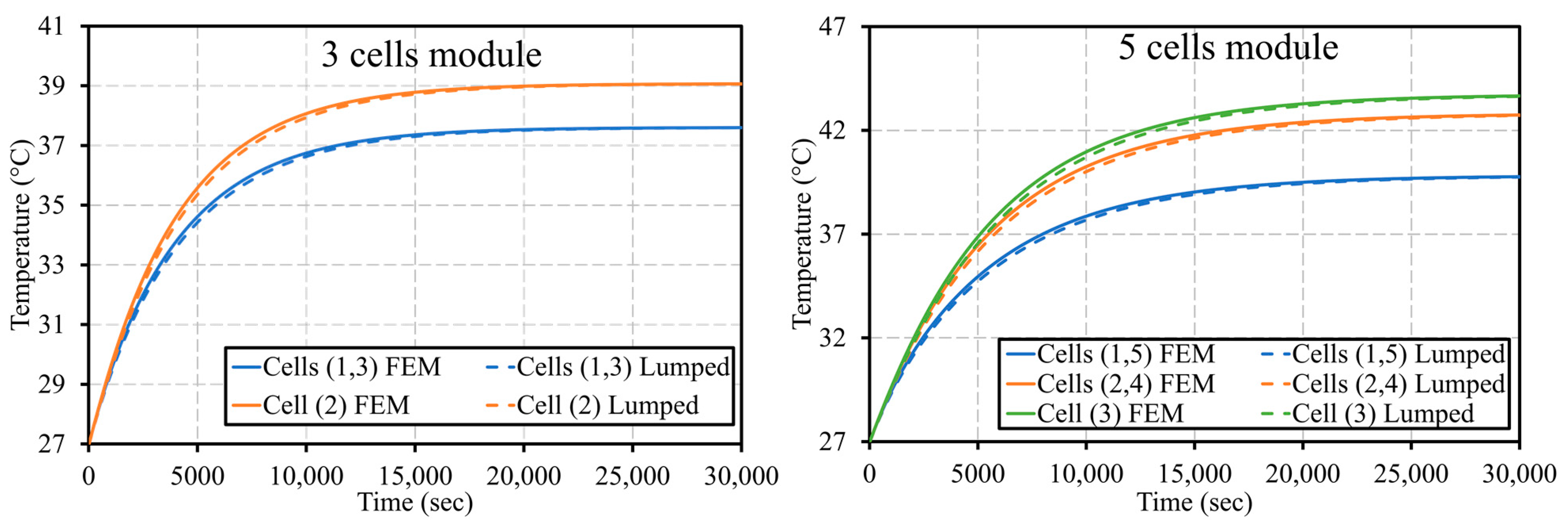

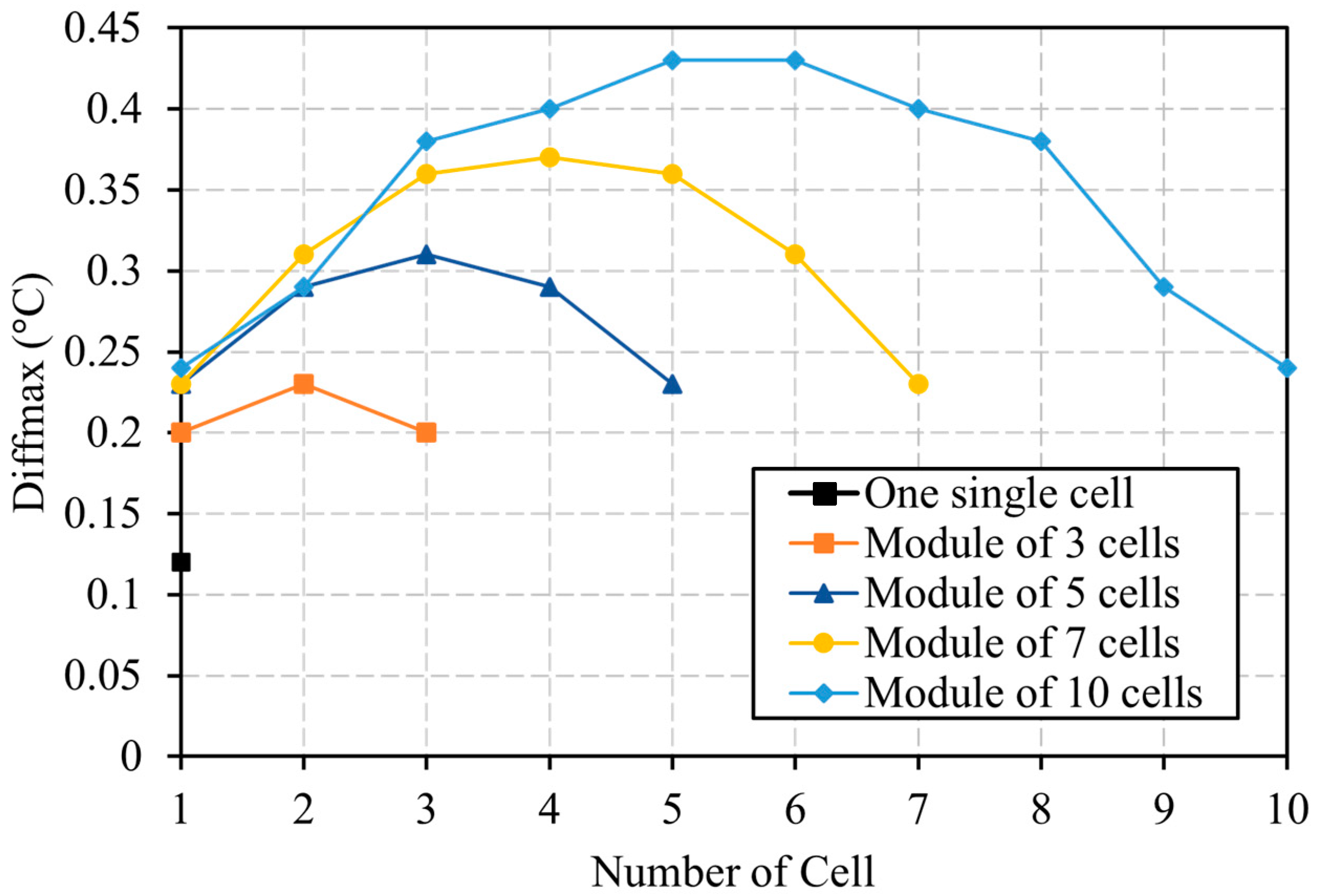
| Thermal Equations | Case | |
|---|---|---|
| (ρ)cell = Qirr − 2[ + + ] − [ + ] | (12) | Cell in single cell |
| (ρ)Al = −2[ + ] − + | (13) | Tab p in single cell or battery module |
| (ρ)Cu = −2[ + ] − + | (14) | Tab n in single cell or battery module |
| (ρ)cell = Qirr − 2[ + ] − − [ − [ + ] | (15) | External cell in battery module |
| (ρ)cell = Qirr − 2[+] − [ − [ − [ + ] | (16) | Internal cell in battery module |
| (ρ)gap = −2[ + ] + [ + [ | (17) | Aerogel layer in battery module |
Disclaimer/Publisher’s Note: The statements, opinions and data contained in all publications are solely those of the individual author(s) and contributor(s) and not of MDPI and/or the editor(s). MDPI and/or the editor(s) disclaim responsibility for any injury to people or property resulting from any ideas, methods, instructions or products referred to in the content. |
© 2024 by the authors. Licensee MDPI, Basel, Switzerland. This article is an open access article distributed under the terms and conditions of the Creative Commons Attribution (CC BY) license (https://creativecommons.org/licenses/by/4.0/).
Share and Cite
Abbas, A.; Rizoug, N.; Trigui, R.; Redondo-Iglesias, E.; Pelissier, S. Low-Computational Model to Predict Individual Temperatures of Cells within Battery Modules. Batteries 2024, 10, 98. https://doi.org/10.3390/batteries10030098
Abbas A, Rizoug N, Trigui R, Redondo-Iglesias E, Pelissier S. Low-Computational Model to Predict Individual Temperatures of Cells within Battery Modules. Batteries. 2024; 10(3):98. https://doi.org/10.3390/batteries10030098
Chicago/Turabian StyleAbbas, Ali, Nassim Rizoug, Rochdi Trigui, Eduardo Redondo-Iglesias, and Serge Pelissier. 2024. "Low-Computational Model to Predict Individual Temperatures of Cells within Battery Modules" Batteries 10, no. 3: 98. https://doi.org/10.3390/batteries10030098
APA StyleAbbas, A., Rizoug, N., Trigui, R., Redondo-Iglesias, E., & Pelissier, S. (2024). Low-Computational Model to Predict Individual Temperatures of Cells within Battery Modules. Batteries, 10(3), 98. https://doi.org/10.3390/batteries10030098









